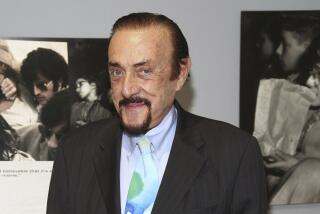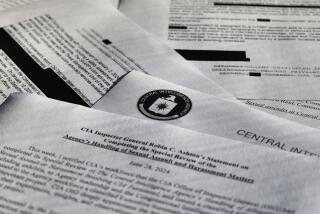Tortured by the past
- Share via
When Bush administration lawyers wrote their memos authorizing extreme interrogation tactics at Guantanamo, they had to conjure up horrible images: Prisoners gagging and sputtering as their interrogators reproduced the sensation of drowning. Human heads slammed repeatedly into walls. Insect-phobic prisoners cowering in fear in 8-by-10-foot cages.
How can the lawyers live with those images? And what damage did the interrogators who used the techniques sustain to their souls?
These are not academic questions for me. As a CIA interrogator in Vietnam during the last five years of the war, I know I put my soul at extreme peril. I am still haunted by what I did, and I suspect that what I witnessed and perpetrated in those years set the stage for the Bush Justice Department’s approach to torture
In the six months leading up to the Vietnam War cease-fire in 1973, I was assigned to debrief eight North Vietnamese and Viet Cong prisoners at the National Interrogation Center in downtown Saigon. I had been trained as an intelligence analyst, not an interrogator. But because I was, by then, one of the CIA’s most knowledgeable experts on North Vietnamese politics and strategy, it was thought I might engage the prisoners in “meaningful” discourse, albeit through translators because I spoke no Vietnamese.
My most challenging interrogation involved Nguyen Van Tai, the highest-ranking enemy officer we captured. A colonel in the North Vietnamese security service, he’d run assassination and terrorist operations against the French during the first Indochina war, and he employed the same brutal tactics against Americans and South Vietnamese officials in Saigon.
In 1970, he stumbled into an ambush and was handed over to South Vietnamese interrogators. According to my former CIA colleague, Merle Pribbenow, who wrote about the case for the CIA’s internal journal, Studies in Intelligence, they beat him, applied electric shock, funneled water into his nose while his mouth was gagged, subjected him to Chinese water torture (continuously dripping water onto the bridge of the nose), kept him strapped to a chair for days without sustenance and hung him from the rafters by his arms for hours.
The most he gave up were false tidbits of a well-crafted cover story. Only when confronted with captured confederates who could identify him, and captured photographs showing him with Ho Chi Minh, did he confess his identity. It was good old-fashioned research and analysis, not torture, that first dented his armor.
Several months later, the CIA, now convinced of Tai’s value, moved him to a windowless, snow-white cell in the National Interrogation Center. Here he was held in isolation for three years, never seeing the dawning of a new day, with the cell’s overhead lights burning continuously and the air-conditioning system set on high because the CIA knew that Tai, like most Vietnamese, believed that cool air shrinks and chokes blood vessels. It was in this disorienting environment that I was introduced to him in the fall of 1972.
I immediately moved to disorient him further, changing his breakfast hour to midnight and his lunch hour to dawn because Tai had already so acclimatized himself to his brave new world that he could tell the time of day by his own body chemistry.
I approached my every session with him steeped in what we knew of his personal history. It was rumored that he had betrayed his father to curry favor with Communist Party officials, and I constantly needled him about this in hopes that anger would loosen his tongue. In addition, I employed an interrogation technique that I liken to jump-cutting film footage, rapidly shifting from one unrelated topic to another, so that he could never be sure what was coming or what he had or had not told me.
The CIA later commended me for “obtaining significant information from the prisoner by maneuvering him into a continuous dialogue and
After the evacuation of Saigon two years later, a CIA colleague told me that Tai had been killed by the South Vietnamese just before the Communist takeover.
As it turns out, that was wrong. Not long ago, Tai published a memoir that deals in part with our interrogation. By his account, he’d gained a last-minute reprieve from his South Vietnamese jailers by pledging to keep them safe once the victorious North Vietnamese entered Saigon.
In his book, Tai asserts that his American interrogators never mistreated him. Indeed, I never laid a hand on him, never humiliated him, and when he asked for medical care, extra rations or clothing, I accommodated him. I even tried to establish rapport by discussing French poetry with him. The deprivation scenario involving isolation and the snow-white room was a throwback to interrogation tactics “perfected” years before by the CIA’s counter-intelligence chief, James Angleton, in a case involving a suspect Soviet defector. I had no part in conceiving it.
But I did become complicit in the psychological manipulation and torment of a prisoner. Never mind that the North Vietnamese inflicted far more brutal treatment on the American inmates of the “Hanoi Hilton.” My “success” in promoting a “dialogue” with Tai was based on his lingering fear that, without dialogue, he would be tossed back to the brutal South Vietnamese -- an impression I encouraged. The isolation, the chilled air, the disorienting new routine were all things I imposed.
My CIA colleagues and I used to rationalize our tactics, and some still insist that psychological intimidation, verbal threats and tight handcuffs are perfectly acceptable in terms of both morality and expediency. But I believe there is an organic connection between the tactics I applied against Tai and those approved by the Bush Justice Department. Controlled brutality is a slippery slope, and once you pass through the moral membrane that should contain our worst impulses, it becomes so very easy to rationalize another step, and yet another, in the wrong direction.
If I had been asked to sign a protocol certifying my personal responsibility for the treatment visited on Tai, and accepting legal liability, I would doubtless have been prompted to think twice about it. Exacting such a protocol from the interrogators at Guantanamo and other such holding pens might give them similar pause.
More to Read
Sign up for Essential California
The most important California stories and recommendations in your inbox every morning.
You may occasionally receive promotional content from the Los Angeles Times.










